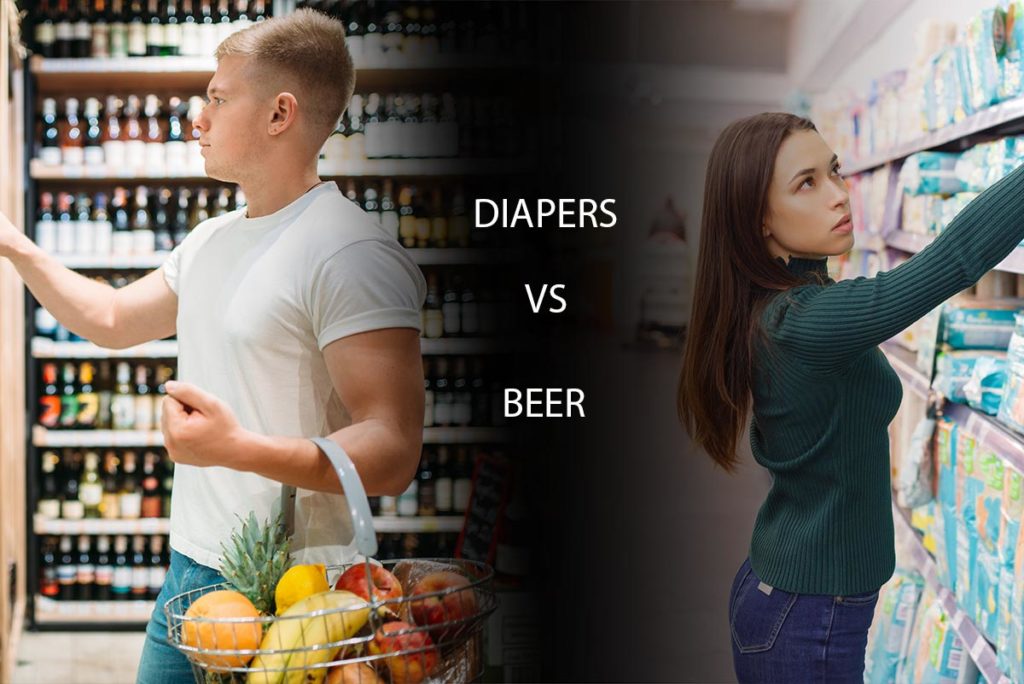
Diapers, Beer, and Data Science in Retail
When asked for white papers or case studies on how predictive analytics works, I often give a few stories on how different industries use analytics to find patterns in their data and then apply that knowledge to their existing data to predict what future trends are going to happen. Learn about how we applied predictive analytics to politics.
I get asked specifically about legends that roam the retail world: the study that found that milk is the most purchased item so it is always in the back of the store, making you walk by everything thing else they have before you get there, the fact that women’s shoes are always on the way to men’s clothes, and the fact that bananas are at the front of stores because they are found to be an impulse buy. The one that seems to get the most requests though is the one that men who buy diapers for their kids are most likely to have beer also in their carts.
It doesn’t seem that far-fetched.
A man coerced into buying a pack of diapers from the corner store by his beautiful spouse on his way home from work, hears the siren song of the pyramid of beautiful cases of beer. So, being that it is Friday night, he picks up a case of beer as well.
The legend says that a study was done by a retail grocery store. The findings were that men between 30- 40 years in age, shopping between 5pm and 7pm on Fridays, who purchased diapers were most likely to also have beer in their carts. This motivated the grocery store to move the beer aisle closer to the diaper aisle and wiz-boom-bang, an instant 35% increase in sales of both.
Many place this at Wal-Mart’s feet, but a quick call to a friend in the analytics department of Wal-Mart yielded that although the myth proliferates their organization too, it wasn’t a Wal-Mart study.
So a Google search ensued. An “I’m feeling lucky” search found an article about how Target was using analytics to find items statistically bought together and placing them next to other impulse buy items in an effort to show you items you might want, while you are buying items you might need.
Andrew Pole, a statistician from Target, said, “If you’re rushing through the store, looking for baby bottles, and you pass orange juice, you’ll grab a carton. Oh, and there’s that new DVD I want. Soon, you’ll be buying cereal and paper towels from us, and keep coming back.”
Okay, so this proves large retail chains do association studies, but where was the origin of this myth?
As it turns out, it’s much older than most of us at CAN thought. It has nothing to do with analytics and everything to do with data mining. Data mining fits into the “analysis” level of sophistication.
The myth itself relates to a study done in June of 1992 when Thomas Blischok, then VP of industrial consulting for NCR (now spun off to Teradata), did an analysis for Osco Drug. They examined 1.2 million market baskets in 25 stores identifying over 20 different product couplings including beer and diapers, and fruit juice and cough syrup.
The story about how Osco moved beer next to the Diapers and both made more sales isn’t correct though. Osco took the NCR study and identified approximately 5,000 slow-moving SKUs in its inventory. After removing those items from the shelf, consumers, now finding more items they wanted easier, actually thought Osco’s selection had increased.
What the Osco and the NCR study did was create a fundamental understanding that buying habits could be used to enhance the whole buying experience. Twenty years later, data mining has been upgraded to business intelligence and predictive analytics. Companies can now think through how and what people buy and layout stores more efficiently. They can offer coupons on items bought together, and have extra stock when demand is going to increase.
“What Osco, and essentially the whole retail industry, began to understand, was that with the examination of data, the right amount of the right merchandise could be put on the shelf at the right time,” said Blischok.
The right amount of the right merchandise at the right time? Sounds like they figured out how to work smart.
Learn more about Predictive Analytics and how to apply it in your organization by downloading our eBook, Predictive Analytics: The Future of Business Intelligence.
We can help you get your organization up and running with Predictive Analytics. Contact us today to see how we can help.


There is another story from a BI analyst, whose wife is an
artist. She had an installation piece
that required a lot of camouflage and artificial water fowl. So
she hit the on-line and retail stores for her material. For years afterward she received catalogs
from most of the major hunting and fishing suppliers. Neither of the people in this story even
camp. Working Smart is important indeed.